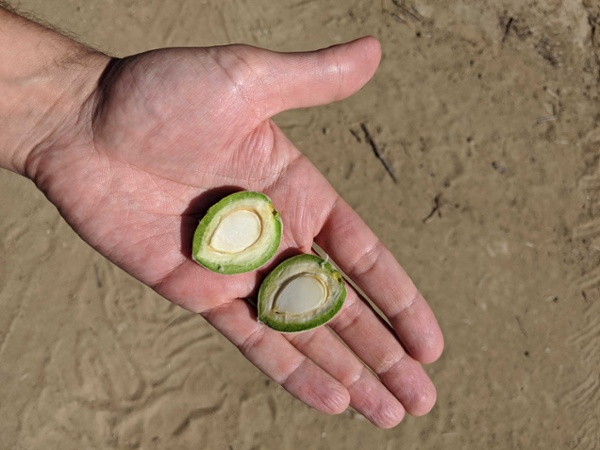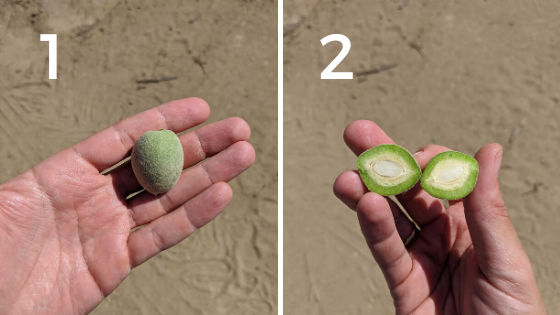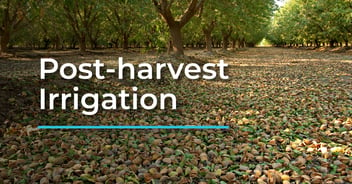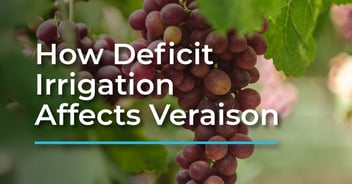
Late spring (late April to early June) is an important time in almond orchard development. During this time, the almond embryo is developing into a mature kernel. At this point in the season, proper irrigation management can be a major contributor to the difference between a marginal and major improvement in crop yield and quality.
Development is complete when the kernel fills the shell entirely, but the kernel will continue to accumulate weight usually until hull split occurs. Insufficient availability of water during this period reduces carbohydrate assimilation and can have negative impacts on kernel weight and gross yields.
Alternatively, inducing water stress can also accelerate hull split which increases exposure to navel orange worm and other pest damage. Ensuring optimal irrigation during the next month or so can mitigate the reduction of in-season yields and keep money in the grower’s pocket.
Not sure what stage of development your almond kernels are at?
Growers can easily evaluate kernel development by slicing an almond hull in half and visually observing the embryonic development.

The embryo grows from the tip of the shell until it fills the space completely. Embryonic growth is preceded by the endosperm and nucellus (a jelly like substance). Using these visual assessments the grower can determine which blocks are less developed and ensure that they provide adequate irrigation until kernel fill is complete. See Fig. 1.

Fig 1. Almond embryo development
In addition to block variability, varietal differences will also affect the timing of kernel development. In most cases the grower will have to make management decisions based on their most profitable variety (e.g. Nonpareil). Early maturing, Nonpareil trees that have started hull split will benefit from reduced irrigation rates while the late-maturing pollinators like Butte and Aldrich are still in the kernel filling stage. It is a trade-off that needs to be made at the grower’s discretion.
Once a timeline is established for kernel development we can focus on monitoring plant available water until the onset of hull split; a process that requires both the estimation of crop water requirements as well as in-field measurements.
Planning water management until the onset of hull split
The most common practice of scheduling irrigation in California is to reference evapotranspiration (ETo) values provided by the California Irrigation Management Information System (CIMIS). Referencing evapotranspiration (ETo), multiplied by established crop coefficients (Kc) will provide an estimate of crop evapotranspiration (ETc) in inches for the day or week.
ETc calculations are a mainstay in any irrigation manager's toolkit and these are provided on the Semios app. However, even ETc is just an estimation of crop water demand and does not evaluate actual consumption. Plant water use can vary substantially from orchard to orchard due to differences in canopy size that reflect Kc variability across orchards.

Evapotranspiration forecast on Semios crop management platform
In addition, when it comes to delivering ETc, growers will want to pay attention to the amount of water available to the plant, as small deviations in ETc estimations could lead to water in the profile being depleted or excessive, increasing the incidence of diseases.
These agronomic factors can impact how easily a plant can extract water from the soil:
- Soil texture
- Infiltration rates
- Water quality
- Effective rooting depth, and other important factors
In an effort to help our customers conserve resources and irrigate with greater precision, we now offer fully integrated soil moisture probes that provide real-time available soil water content displayed on the Semios app.
About Semios Water Management Tools
Semios Soil Moisture Monitoring
The soil moisture probe measures available water content (AWC %), and temperature.
Each probe is remotely calibrated using our artificial intelligence approach which determines field capacity (FC) and permanent wilting point (PWP) automatically.
The irrigation manager defines a percent of field capacity known as manageable allowable depletion (MAD %), which becomes the irrigation threshold i.e. the time to refill the soil profile.
One of the main advantages of this soil moisture probe is that it does not require routine in-field maintenance, unlike many other commercially offered probes. Having the soil moisture probe data readily available on the Semios web and mobile app takes the guesswork out of knowing how much water is available to your trees at a time when they need it the most.
Chart and map of a field's available water content on Semios crop management platform
Site-Specific Evapotranspiration (ET)
This feature gives irrigation managers site-specific, in-canopy weather measurements with a 7-day forecast.

Map showing a 7-day ET forecast by block on Semios crop management platform
Irrigation Activity
Real-time monitoring of irrigation set duration tells you how long your water is running. This tool is especially useful to track irrigation for compliance.

A map showing irrigation activity and a chart showing PSI readings on Semios crop management platform
Want to learn more about how Semios can help?
If you have any questions about Semios or our collection of water management tools, fill out the form below and we'll get in touch with you:
Related Posts
Benefits of In-Canopy Weather Stations
Comparing Degree Day Tracking Sources for Navel Orangeworm Generation Flight Prediction




